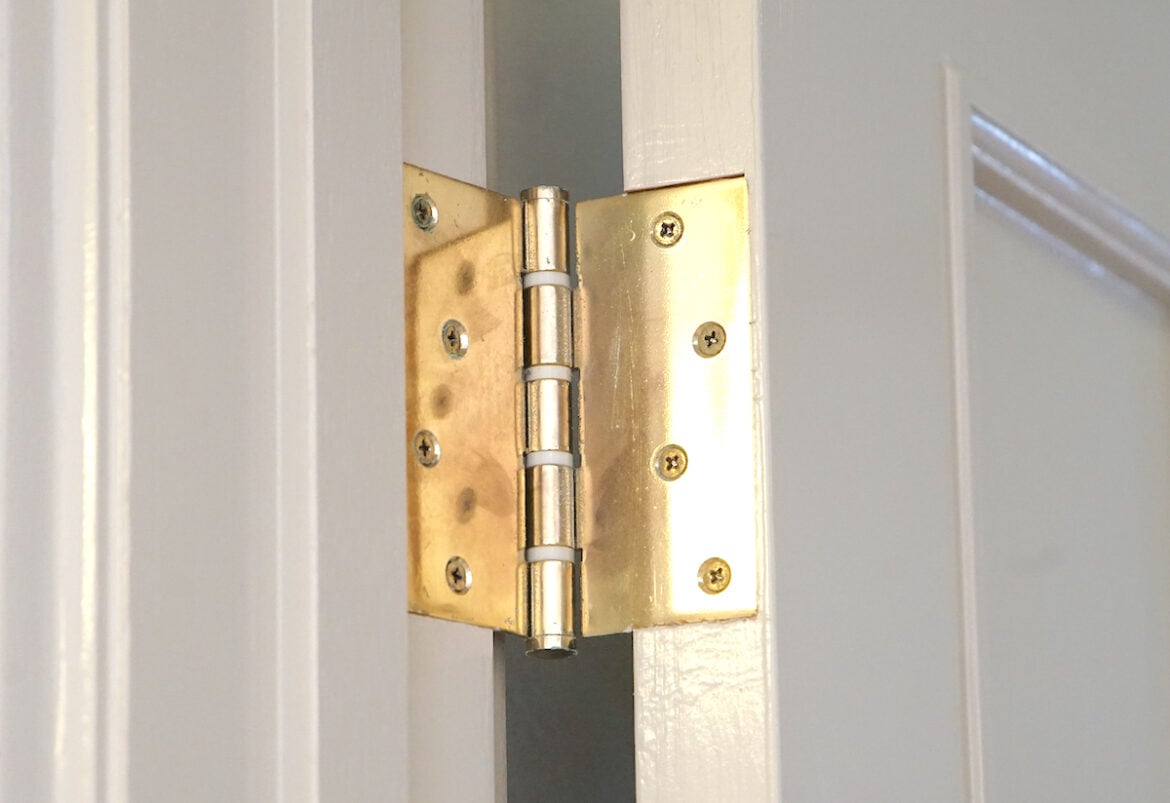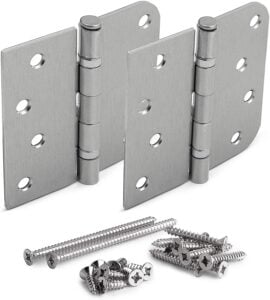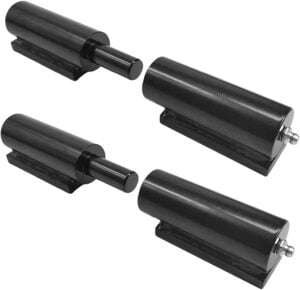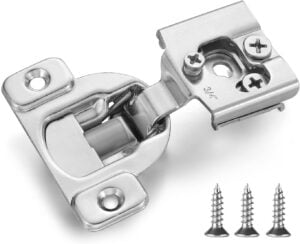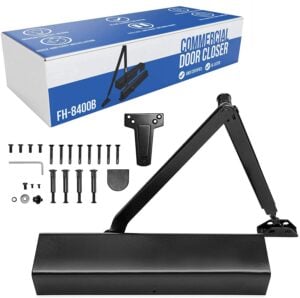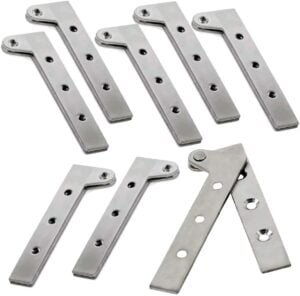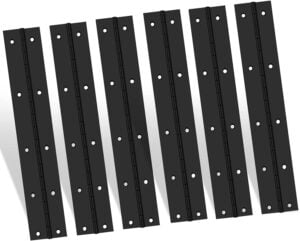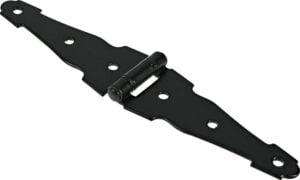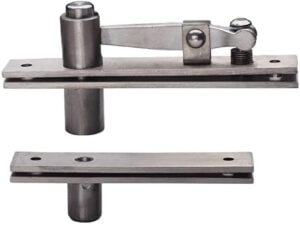Hinges are an integral part of the construction process, but even though you may have hundreds of them in your own home alone, you may have never stopped to consider exactly how they work.
So, how do hinges work? There are many different types of hinges, and each functions a bit differently to allow you to open doors, drawers, windows, and more. One of the most common ones is a door hinge, which works using two wings (or leaves) rotating around a cylindrical axis.
Here, you will learn everything you need to know about hinges, including how they work, what types of hinges are available on the market, and more. So, first off, let’s begin with a brief introduction to hinges.
What Are Hinges?
Hinges are mechanical bearings that allow for a limited and fixed range of rotational movement between two workpieces. Doors, for instance, attach to their frames with hinges which enable them to swing open. The door eventually reaches an imposed limit of the space where it can swing out without hindrance.
Hinges generally have three essential parts: bearing surfaces (typically consisting of bronze or steel), pin designs (often including rivet heads on either end affixed by taper pins), and shafts, typically made out of rigid materials like stainless steel.
The Different Parts Of Hinges
Leaf
A leaf is a rectangular-shaped plate that rotates with the workpiece to which it’s connected. With the exception of flag hinges, most hinges contain two leaves.
To install a hinge, screws are driven into these holes on either side and then fastened together at their center point for maximum support across all joints.
Knuckle
Knuckles are also known as loops or nodes, and they’re hollow tubes that run down the middle of a hinge. The knuckle isn’t actually an independent part; instead, it’s created when two leaves on a hinge meet up to form one amazing tube.
When these leaves come together, there is space between them which forms what we call “the knuckle.”
Pin
A pin connects the hinges on a door. A pin is a small rod-like object inserted through the hollow center of a hinge to hold it together. The hinge’s leaves create an open space between them, and it is through these spaces that pins can be inserted to hold both leaves together.
The pin prevents one of the two leaves from separating when movement is applied; without it, there’d be nothing keeping your door or window shut.
Types Of Hinges
There are many different types of hinges, each with their own pros and cons. In this section, we will explore the various types of hinges available on the market today and how they can help you in your everyday life as well as what makes them so unique.
1. Ball Bearing Hinge
See Suggested Product on Amazon
A ball bearing hinge is a metalwork hinge device that does not have a return spring and self-balances. These hinges consist of two clips connected by an elongated rod or post.
It provides stability by preventing the door from rotating away from the frame rail until it clears the stop. Now, at this point, gravity takes over and expels most of the accumulated energy in keeping with Newton’s third law of motion.
So, unlike other hinges, ball bearing hinges need almost no maintenance and can be exposed to outdoor elements for long periods without degradation in function. In addition, they make pushing open doors smoother because one complete turn opens them more than 180 degrees.
2. Barrel Hinge
See Suggested Product on Amazon
A barrel hinge is an extruded metal bar through which a screw is threaded. It’s very similar in shape to the shape of a barrel, giving the hinge its name.
They can be found on doors and cabinets and typically work best with heavier doors or drawers.
Barrel hinges are incredibly versatile, but they’re not ideal for vertical or load-bearing applications. These types of jobs require concealed hinges that can be seen from either side and open to 180 degrees.
3. Concealed Hinge
See Suggested Product on Amazon
Invisible hinges are used on entry and interior doors, cabinets, and furniture for a sleek look. They’ve been around for over 100 years. Invisible hinges provide security because they can’t be tampered with.
However, they also offer an aesthetically pleasing appearance that doesn’t have any breaks in it like other types.
4. Heavy-Duty Hinge
See Suggested Product on Amazon
Heavy-duty hinges are designed to provide stability and support for heavy doors. These can be entry doors, gates, or furniture lids like trunks and benches.
Ball-bearing hinges, concealed hinging mechanisms, as well as piano hinging systems come in different versions of the heavy-duty variety.
However, you’ve likely seen some like the one pictured here, which are more complicated automatic hinges that also slow the door from closing too hard or fast and hurting someone.
5. Knife Hinge
See Suggested Product on Amazon
A knife hinge is a type of pivot hinge, and it’s shaped like scissors.
The two parts are connected by the pivot point, which is why these hinges also called “pivot” or “overlay” hinges.
You’ll find them primarily in cabinets for overlay or inset doors where they’re barely noticeable once installed. This means that you won’t have to remove any door panels just because there isn’t enough space around your cabinet frame.
6. Piano Hinge
See Suggested Product on Amazon
The piano hinge is a continuous hinge with a central pin and same-sized leaves that run the length of whatever they’re attached to.
The name comes from its use on pianos, but it has many other applications. For instance, it is used on fold-down workbenches or desks, cabinet doors, and storage boxes.
7. Strap Hinge
See Suggested Product on Amazon
A strap hinge has long, narrow leaves that provide extra stability in heavy-duty applications.
They have long, narrow leaves and provide additional stability for heavy doors or lids. They’re frequently used outdoors on gates or as an indoor design element for doors and decorative chests.
8. Pivot Hinge
See Suggested Product on Amazon
Pivot hinges are installed at the top and bottom of a door and allow it to swing from a single point. They can handle heavier doors than some other hinges.
And because you can open pivot-hinged doors with just one push, they’re an excellent choice in restaurants and homes for doorways between kitchens or dining rooms.
How Do Door Hinges Work?
Door hinges are the mechanical bearings that allow a door to open and close. They connect two solid objects, such as a frame and a door.
These work by rotating around an axis to move smoothly from point A (closed) and point B (open). They typically consist of steel or brass but can also be made out of stainless steel, making them more durable than their counterparts.
Door hinges work by having the vertical door resting on a horizontal hinge and connecting to the door frame with leaves or panels. When closed, strike-plates are mounted on either side of the hinge just below the top surface of the door. A hinge leaf is typically rectangular and can be made from metal, zinc-plated steel, or nylon-engineered plastic.
How Do Soft Close Hinges Work?
The soft close hinge on a cabinet, door, or drawer operates using one spring to push the latch that retains its other side closed. They move freely and gradually farther apart without requiring any external force for them to remain in place until they’re entirely open.
At this point, there’s no protrusion on the other side of the door to hold it shut anymore, so gravity will naturally pull it open even further.
However, they have one spring that pushes up against the latch with some force down towards its base-mounted axle hole. This is why every time you let go of the handle, it would catch onto this protrusion and stop from opening any more than 10 degrees at a time.
How Do Cabinet Hinges Work?
Cabinet hinges work by attaching two hinged pieces of wood that pivot around pins. The pins are parallel to the edge of the door, so it crafts an angle when the hinge is left in its regular position. The principal component in this process is friction, which separates and seals the two doors.
For this reason, you should always place your door at a 90-degree angle against any walls or other objects in order to preserve your cabinet’s geometry and finish.
How Do Self Closing Hinges Work?
Self-closing hinges are typically added to items that do not have any other means of self-closing and provide a quick, simple solution. These are powered by a solid all-metal coiled spring recoiled manually or with the flick of a switch.
The design includes guide rails that help it move in the opposite direction when the door is opened again and an internal catch prevents pinching fingers.
For the door to rebound after being closed, there must be enough force pushing on it. If not closed forcefully enough, gravity will eventually cause them to close once more on their own accord.
How To Select The Right Hinge
When looking for hinges, it’s essential to know what kind of cabinets and doors you have. Here are the factors to consider while choosing the perfect hinges.
1. Consider Your Project
Hinges are an essential component of many kinds of projects, but not all hinges are created equal. Knowing which type to look for is the first step towards a successful project. You have to determine the weight and size of what is being hinged.
On the one hand, if it’s a lighter object, then a simple piano hinge will be more than sturdy enough and should do just fine. For heavier objects, things get a little bit trickier and you may want to consider soft-close or automatic hinges.
Whatever your project, make sure the hinge you choose is up for the job.
2. Door Weight
Another step in selecting hinges will decide what type of materials you will be using on your project. Wood, metal, plastic, or another material could all work for this, and the type of hinge that will fit best depends upon the structure they are supporting once completed.
Therefore, understanding the weight-bearing capabilities is a significant part of choosing how heavy-duty a hinge needs to be.
3. Aesthetic Appeal
Hinges can come in many different styles and have a way of making or breaking the look of a door. Regular door hinges are so popular because they are sleek and inconspicuous, but other hinges, such as strap hinges, can come in more elaborate designs to add something to the overall aesthetic rather than simply blending in. Choose a design that appeals to your sense of style.
4. Mounting
If the hinge is for a door, it needs to be mounted flush on the left or right side of the hinge. If it’s a cabinet, mounting screws should not show through on the outside. For this type of mounting, there are two options for placement: rear-hinged and no spring.
For instance, some people prefer no-spring hinges or front-hinged mounts in the kitchen. This is mainly because they want their cabinet doors opening away from an adjacent wall, so the mounting type matters a lot.
5. Clearance
You will need a door that swings out in alignment with the door frame for the best clearance. This means that they should be aligned with your wall and perpendicular to each other. Inadequate headroom clearance can result in hardware scraping against walls or not touching a surface ultimately.
So make sure you’ve measured before you plan to install a hinge. It’s best to measure and create an opening at least 1 1/8 inches wider and higher than your door. Not to mention, getting the height measurement sized right is key to any successful project. So, don’t underestimate this step.
Up Next: Types Of Wood Veneer
